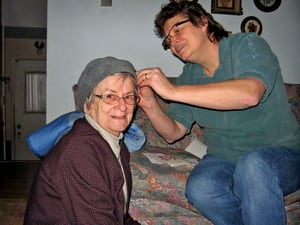The Tweaker
The real genius of Steve Jobs.
「ザ・凝り性」 スティーブ・ジョブスの真骨頂
by Malcolm Gladwell November 14, 2011
続きの訳が遅れてすみませんでした。 1/2 と続けてお読みください。
続き

This guy badgered me about how Microsoft was going to completely change the world with this tablet PC software and eliminate all notebook computers, and Apple ought to license his Microsoft software. But he was doing the device all wrong. It had a stylus. As soon as you have a stylus, you’re dead. This dinner was like the tenth time he talked to me about it, and I was so sick of it that I came home and said, “Fuck this, let’s show him what a tablet can really be.”
この男はうるさく私に付きまとって、いかにマイクロソフトがこのタブレットPCソフトウェアで世界を一変させようと考えているか、そしてノートブック型コンピュータを業界から一掃しようとしているかを語り、アップルは、このマイクロソフトのソフトウェアをライセンス生産すべきだと話した。 しかし、彼のそのタブレットは全くダメな代物だった。なぜならスタイラスを付けていたからだ。スタイラスに依存すると、タブレットは全く魅力がないものになる。 このディナーで同じ話を聞くのが、恐らく10回目くらいだったので、うんざりした。 私は帰宅して、思わずこう言った。 「くそったれ、本物のタブレットというものを見せてやろう。」
Even within Apple, Jobs was known for taking credit for others’ ideas. Jonathan Ive, the designer behind the iMac, the iPod, and the iPhone, tells Isaacson, “He will go through a process of looking at my ideas and say, ‘That’s no good. That’s not very good. I like that one.’ And later I will be sitting in the audience and he will be talking about it as if it was his idea.”
Jobs’s sensibility was editorial, not inventive. His gift lay in taking what was in front of him—the tablet with stylus—and ruthlessly refining it. After looking at the first commercials for the iPad, he tracked down the copywriter, James Vincent, and told him, “Your commercials suck.”
アップル社の中でも、ジョブスは人のアイデアを横取りすることで有名だ。 アイマック、アイポッド、そしてアイフォンの影のデザイナーであるジョナサン・アイブはアイザックソンにこう語っている。「彼は私のアイデアを一通りその過程までみて、経験して、これはダメだと言います。」「これはダメだ、あちらがいいと、ところが後で彼のプレゼンを後ろで聞いていると、彼は私のアイデアをあたかも自分のアイデアのように話しているのです。」 ジョブスの感性はその編集力に発揮されていたのであって、発明ではなかった。 彼の才能は、彼の前に提示されたものを・・・例えばスタイラス付のタブレットを・・・・徹底的に洗練するところにこそ発揮された。 アイパッドの最初のコマーシャルフィルムを見た後で、彼は、コピーライターのジェームス・ヴィンセントを見つけて、彼に「お前のコマーシャルは最低だ」と言っている。
“Well, what do you want?” Vincent shot back. “You’ve not been able to tell me what you want.”
“I don’t know,” Jobs said. “You have to bring me something new. Nothing you’ve shown me is even close.”
Vincent argued back and suddenly Jobs went ballistic. “He just started screaming at me,” Vincent recalled. Vincent could be volatile himself, and the volleys escalated.
When Vincent shouted, “You’ve got to tell me what you want,” Jobs shot back, “You’ve got to show me some stuff, and I’ll know it when I see it.”
「で、どんなことを望まれているのですか?」 「何を望んでいるか、あなたは私におっしゃることが出来なかったじゃないですか。」 とビンセントもやり返した。 「そんなこと知るか」 「何か新しいものをもってこい、いま見せているのはちっとも新しくない、かすりもしていない。」とジョブスは言った。 ビンセントが、これに言い返すと、突然ジョブスはキレだして「彼は私を怒鳴りつけました。」とビンセントは回想した。 ビンセントもどちらかと言えばカッとするタイプであり、二人のやり合いはエスカレートしたという。 ビンセントが「どうして欲しいのか言ってみろ。」と言うと、ジョブスは「まともなものを見せてくれ、そうしたら一目で俺は選んでやるよ。」と応じた。
I’ll know it when I see it. That was Jobs’s credo, and until he saw it his perfectionism kept him on edge. He looked at the title bars—the headers that run across the top of windows and documents—that his team of software developers had designed for the original Macintosh and decided he didn’t like them. He forced the developers to do another version, and then another, about twenty iterations in all, insisting on one tiny tweak after another, and when the developers protested that they had better things to do he shouted, “Can you imagine looking at that every day? It’s not just a little thing. It’s something we have to do right.”
見たら、すぐに私にはわかる。 この台詞はジョブスの信条である。 そして彼は「わかる」まで、完璧主義の刃の切っ先を降ろさない。 彼は会社のかつてタイトルバーを見たことがあった・・・ショーウィンドや書類の上に付けるヘッダー(見出し)だ・・・・それはジョブスのソフトウェアの開発チームが元のマッキントッシュの為にデザインし、決めたものだが、彼はそれが気に入らなかった。 彼は開発チームに他のバージョンにするように言い、そしてまた変え、細かいところに拘り続けて20回ほど変え、開発チームが散々いいものを出し尽くしたと抗議すると、彼は怒鳴ってこう言った「こんなのを毎日見ることを想像できるか? それは些細なことじゃないんだよ。それはチャンとしたものじゃなきゃいけないんだ。」と
The famous Apple “Think Different” campaign came from Jobs’s advertising team at TBWA/Chiat/Day. But it was Jobs who agonized over the slogan until it was right:
They debated the grammatical issue: If “different” was supposed to modify the verb “think,” it should be an adverb, as in “think differently.” But Jobs insisted that he wanted “different” to be used as a noun, as in “think victory” or “think beauty.” Also, it echoed colloquial use, as in “think big.” Jobs later explained, “We discussed whether it was correct before we ran it. It’s grammatical, if you think about what we’re trying to say. It’s not think the same, it’s think different. Think a little different, think a lot different, think different. ‘Think differently’ wouldn’t hit the meaning for me.”
有名なアップルのキャンペーンフレーズ「シンク ディファレント」は広告代理店TVWA/Chiat/Dayのジョブスの広告チームが作ったものだが、ジョブスは、ここでも、このスローガンで納得するまで、頭を悩まし続けることになる。 彼等は文法の事を話し合った。つまり、もしディファレントがシンクという動詞にかかるなら、ディファレントは副詞であるべきだから「シンク ディファレントリー」にならなくてはいけない。しかしジョブスは「ディファレント」という言葉を名詞として使うことに拘った、「シンク ビクトリー」「シンク ビューティ」のように。 それは口語的な響きがいい。 例えば「シンク ビッグ」のように。 ジョブスは後にこう説明している。「我々はそれを使う前に、それが正しいかどうかを話し合った。 もし、我々が、それはシンク ザ・セームじゃなくて、シンク ディファレントだという風に訴えたかったのなら、文法的に合っている。 つまり、シンク ア・リトル・ディファレント、シンク ア・ロット・ディファレント。 そう、シンク ア・リトル・ディファレント、シンク ア・ロット・ディファレントで、シンク ディファレントとなる。 そう考えるとシンク ディファレントリーは私の意図することを表していないということになる。
The point of Meisenzahl and Mokyr’s argument is that this sort of tweaking is essential to progress. James Watt invented the modern steam engine, doubling the efficiency of the engines that had come before. But when the tweakers took over the efficiency of the steam engine swiftly quadrupled. Samuel Crompton was responsible for what Meisenzahl and Mokyr call “arguably the most productive invention” of the industrial revolution. But the key moment, in the history of the mule, came a few years later, when there was a strike of cotton workers. The mill owners were looking for a way to replace the workers with unskilled labor, and needed an automatic mule, which did not need to be controlled by the spinner. Who solved the problem? Not Crompton, an unambitious man who regretted only that public interest would not leave him to his seclusion, so that he might “earn undisturbed the fruits of his ingenuity and perseverance.” It was the tweaker’s tweaker, Richard Roberts, who saved the day, producing a prototype, in 1825, and then an even better solution in 1830. Before long, the number of spindles on a typical mule jumped from four hundred to a thousand. The visionary starts with a clean sheet of paper, and re-imagines the world. The tweaker inherits things as they are, and has to push and pull them toward some more nearly perfect solution. That is not a lesser task.
マイセンザールとモーカーの議論のポイントは、このような「凝り性」が技術の進歩に不可欠だということです。 ジェームス・ワットは、それ以前に世に出ていたエンジンの効率を2倍にして、近代的な蒸気エンジンを発明しました。 しかし、それを引き継いだ「凝り性の人々」が、あっと言う間に蒸気効率を4倍にしたのです。 サミュエル・クロンプトンはマイセンザールやモーカーが言うところの、間違いなく、産業革命時代の最も生産的な発明家に値します。 しかし、ミュール紡織機の鍵となる瞬間は、その数年後にやってくるのです。それは綿工場の労働者のストライキがあったときです。 紡織機の工場経営者は職工を未熟練工で代用できないか方策を考えており、紡織工に頼る必要がない自動紡織機の需要が高まっていたのです。 では、それを解決したのは誰なのでしょう? クロンプトンではないのです。彼は別に野心がある訳でもなく、むしろ、自分の創造力や忍耐力の成果をそっとして欲しかったのに、彼の静かな隠遁生活が人々の関心で邪魔されたのを慨嘆するような人物でした。 その人は「凝り性の中の凝り性」とも言うべき人物、リチャード・ロバーツです、彼は1825年に試作品を生み出し、業界を窮地から救ったのです。そして1830年にはさらに改良して良い物を作りました。それからほどなくして、典型的なミュール紡織機のスピンドルの数が400から一気に1000へと増えたのです。 先見性のある人は、真っ白な紙から、独特の世界を生み出します。 これに対し「凝り性」と言われる人々は、既にあるものを受け継ぎ、そしてより完成されたものへ、工夫に工夫を凝らしていくのです。 それは決して前者に劣らず大変な能力を必要とする仕事なのです。
Jobs’s friend Larry Ellison, the founder of Oracle, had a private jet, and he designed its interior with a great deal of care. One day, Jobs decided that he wanted a private jet, too. He studied what Ellison had done. Then he set about to reproduce his friend’s design in its entirety—the same jet, the same reconfiguration, the same doors between the cabins. Actually, not in its entirety. Ellison’s jet “had a door between cabins with an open button and a close button,” Isaacson writes. “Jobs insisted that his have a single button that toggled. He didn’t like the polished stainless steel of the buttons, so he had them replaced with brushed metal ones.” Having hired Ellison’s designer, “pretty soon he was driving her crazy.” Of course he was. The great accomplishment of Jobs’s life is how effectively he put his idiosyncrasies—his petulance, his narcissism, and his rudeness—in the service of perfection. “I look at his airplane and mine,” Ellison says, “and everything he changed was better.”
ジョブスの友人であり、オラクル社の創業者であるラリー・エリソン氏はプライベートジェット機を所有しており、凝りに凝って内装を設計しました。ある日、ジョブスもプライベートジェットを購入しようと決心し、エリソンがやったことを勉強しました。そして彼は、エリソンのデザインを全部真似たのです。当然同じジェット機で、同じ構成にして、キャビン間のドアも同じにしました。 しかし、実を言うと、そっくりそのままではありませんでした。 エリソンのキャビン間のドアはオープンとクローズのボタンがついていましたが、ジョブスは一つのトグルボタンに拘りました。 また彼は磨き上げたステンレスのボタンが嫌いだったので、それを刷毛目のついたメタルに替えました。 エリソンのデザイナーを雇い、当然だが、すぐに彼女をクタクタにしてしまいました。 もちろん神経をすり減らしたのはジョブスも同じです。 彼の人生の偉大な業績は、彼の独特の異常な特異性、即ち癇癪持ち、ナルシズム、無礼さなどを如何に効果的に完全主義に転化していくかという点にかかっています。 「私は彼のジェットと私のジェットを改めて比較してみたけど、彼が手を加えて変えたところは全部彼のものが優れていたよ。」とオラクルのエリソンは話している。
The angriest Isaacson ever saw Steve Jobs was when the wave of Android phones appeared, running the operating system developed by Google. Jobs saw the Android handsets, with their touchscreens and their icons, as a copy of the iPhone. He decided to sue. As he tells Isaacson:
Our lawsuit is saying, “Google, you fucking ripped off the iPhone, wholesale ripped us off.” Grand theft. I will spend my last dying breath if I need to, and I will spend every penny of Apple’s $40 billion in the bank, to right this wrong. I’m going to destroy Android, because it’s a stolen product. I’m willing to go to thermonuclear war on this. They are scared to death, because they know they are guilty. Outside of Search, Google’s products—Android, Google Docs—are shit.
アイザックソンがかつて見たことがないほどスティーブジョブスが怒ったのは、彼がグーグルのOSで動くアンドロイドが出現したときだった。 彼はアンドロイドのハンドセットを見て、アイコンやタッチスクリーンがアイフォンのコピーであると知り、告訴することを決心した。 アイザックソンに次のように語っている。我々の告訴は「グーグルのクソ野郎がアイフォンを騙した。卸しの会社が我々を騙した。」と言っているのだ。必要ならば、この大泥棒を死ぬまで追求してやる、そして、アップルの銀行にある400億ドルの全てを使ってでも、この不正を正す。 私はアンドロイドをぶっ潰してやる、なぜならそれらは盗品以外のなにものでもないからだ。 私はこの熱核戦争に喜んで宣戦布告する。 彼らは死ぬ思いをするだろう、なぜなら彼等自身が自分の罪を認識しているからさ。 検索機能以外、グーグルの製品、アンドロイド、グーグルドックスはみんなカスだ。
In the nineteen-eighties, Jobs reacted the same way when Microsoft came out with Windows. It used the same graphical user interface—icons and mouse—as the Macintosh. Jobs was outraged and summoned Gates from Seattle to Apple’s Silicon Valley headquarters. “They met in Jobs’s conference room, where Gates found himself surrounded by ten Apple employees who were eager to watch their boss assail him,” Isaacson writes. “Jobs didn’t disappoint his troops. ‘You’re ripping us off!’ he shouted. ‘I trusted you, and now you’re stealing from us!’ ”
1980年代にも、同様にジョブスが激怒したことがあった。それはマイクロソフトがウィンドウズを発売したときだった。 それがアイコン、マウスといった、マッキントッシュと同じグラフィカルなユーザーインターフェイスを使っていたからだった。 ジョブスは激怒し、ゲイツをシアトルからアップルのシリコンバレーの本社に呼び付けた。「彼らはジョブスの会議室で会うことになったが、ゲイツはアップルの従業員に取り囲まれていた。彼らは、ボスであるジョブスがゲイツを攻撃するのを見たかったのである。ジョブスは社員の期待通り「お前は騙したな!」と叫び「信じていたのに、我々から盗みやがって!」と言った。
Gates looked back at Jobs calmly. Everyone knew where the windows and the icons came from. “Well, Steve,” Gates responded. “I think there’s more than one way of looking at it. I think it’s more like we both had this rich neighbor named Xerox and I broke into his house to steal the TV set and found out that you had already stolen it.”
ゲイツは静かにジョブスを見つめ返した。 誰もウィンドウズやアイコンが本当はどこからのものか知っていた。 「いいかいスティーブ」とゲイツは切り出した。 「僕は、それにはもう一つの見方があると考えているんだ。 我々は二人ともゼロックスというお金持ちのご近所にテレビを盗みに侵入したんだ、そして君はそれがもう先に盗まれていると言っているようなもんだ。」
Jobs was someone who took other people’s ideas and changed them. But he did not like it when the same thing was done to him. In his mind, what he did was special. Jobs persuaded the head of Pepsi-Cola, John Sculley, to join Apple as C.E.O., in 1983, by asking him, “Do you want to spend the rest of your life selling sugared water, or do you want a chance to change the world?” When Jobs approached Isaacson to write his biography, Isaacson first thought (“half jokingly”) that Jobs had noticed that his two previous books were on Benjamin Franklin and Albert Einstein, and that he “saw himself as the natural successor in that sequence.” The architecture of Apple software was always closed. Jobs did not want the iPhone and the iPod and the iPad to be opened up and fiddled with, because in his eyes they were perfect. The greatest tweaker of his generation did not care to be tweaked.
ジョブスは他人のアイデアをとり、それらを改良していていく人物だ。 しかし、彼は同じことを自分がされることを好まなかった。 彼の心の中では、彼がしたことは特別のことなのだった。 ジョブスはペプシコーラのトップであったジョン・スカリーを説得して1983年にアップルのCEOに迎えている。この時の口説き文句が「君は後半の人生を、砂糖水を売るのに費やすのかい? 世界を変えるチャンスをつかみたいと思わないのか?」だった。 ジョブスが彼自身の伝記を書いてもらうためにアイザックソンと接触したとき、彼はアイザックソンの著作の前の2つの伝記がベンジャミン・フランクリンであり、アルバート・アインシュタインであることを知っていた、とアイザックソンは(半ば冗談ではあるが)考えている。 つまり、彼は自分自身を、これら巨人の系譜の中に当然自分が位置する資格があると見ていた。 アップルのソフトの設計はつねにクローズドあった。 彼はアイフォン、アイポッドそしてアイパッドをオープンにして、いじられるのを望まなかった。なぜなら、彼の眼にはそれらは既に、手を加える必要のない「完璧」なものだからだ。 彼の時代の、この偉大な凝り性の変わり者は、そうであることを全うしたのである。
Perhaps this is why Bill Gates—of all Jobs’s contemporaries—gave him fits. Gates resisted the romance of perfectionism. Time and again, Isaacson repeatedly asks Jobs about Gates and Jobs cannot resist the gratuitous dig. “Bill is basically unimaginative,” Jobs tells Isaacson, “and has never invented anything, which I think is why he’s more comfortable now in philanthropy than technology. He just shamelessly ripped off other people’s ideas.”
おそらく、これがなぜビルゲイツ(ジョブスの全ての面で同時代の仲間)がジョブスを怒らせる理由だろう。ゲイツにはジョブスの完全主義のようなロマンチックな考えはない。 アイザックソンは何度となく、ジョブスにゲイツについて尋ねているが、ジョブスはどうしても、根拠のない嫌味を彼については言ってしまう。 曰く「ビルは基本的に創造性に欠けている、そして何も発明していない。だからテクノロジーよりも慈善事業に心地よさを感じているんだ。 彼は他の人のアイデアを盗む恥知らずだよ。」等々
After close to six hundred pages, the reader will recognize this as vintage Jobs: equal parts insightful, vicious, and delusional. It’s true that Gates is now more interested in trying to eradicate malaria than in overseeing the next iteration of Word. But this is not evidence of a lack of imagination. Philanthropy on the scale that Gates practices it represents imagination at its grandest. In contrast, Jobs’s vision, brilliant and perfect as it was, was narrow. He was a tweaker to the last, endlessly refining the same territory he had claimed as a young man.
600ページに及ぶこの本で、読者はこれがジョブスの真骨頂だと知るだろう。 先見性の溢れ、意地悪で、時に幻滅させられる。 確かにゲイツが、今はワードの次を考えるより、世界からマラリアを根絶することに関心を持っているのは事実である。 しかし、これが彼の創造力が欠如している証拠とは言えない。 ゲイツがやっている慈善活動のスケールは、その壮大さに於いて創造力に溢れているとさえ言える。 これに比し、素晴らしく、完璧でさえあったジョブスのビジョンは非常に狭い。 彼は、最後の最後まで徹底した凝り性であった。 同じ領域で際限のない洗練性の追求に若者のようにのめり込んで行ったのだ。
As his life wound down, and cancer claimed his body, his great passion was designing Apple’s new, three-million-square-foot headquarters, in Cupertino. Jobs threw himself into the details. “Over and over he would come up with new concepts, sometimes entirely new shapes, and make them restart and provide more alternatives,” Isaacson writes. He was obsessed with glass, expanding on what he learned from the big panes in the Apple retail stores. “There would not be a straight piece of glass in the building,” Isaacson writes. “All would be curved and seamlessly joined. . . . The planned center courtyard was eight hundred feet across (more than three typical city blocks, or almost the length of three football fields), and he showed it to me with overlays indicating how it could surround St. Peter’s Square in Rome.” The architects wanted the windows to open. Jobs said no. He “had never liked the idea of people being able to open things. ‘That would just allow people to screw things up.’ ”
彼の命の灯が揺らぎ、癌が彼の身体を蝕むにつれ、彼の壮絶な情熱はアップルの新しい300万平方フィートのクパーチノの本社の設計に注がれることになる。 ジョブスは己の全てをそのディテールに注ぎこんだ。 「何回も何回も、彼は新しいコンセプトを思いついては、時には全てを書き換え、そして、また描き始め、もっと多くの変更を加えた。」とアイザックソンは書いている。 彼はガラスに凝っていた。アップルの小売店で見た大きなガラス板から発想を得て、それをスケールアップさせたものを考えていた。 「ビルは、どこをとっても、真っ平らなガラスが無いようになっている。 全てガラスの面は曲線で出来ており、そこには継ぎ目がない・・・計画された中央の広場は800フィート(典型的な市街地の3ブロック分、アメフト場3面分)に及ぶ、そして彼は、オーバーレイを使って、ローマのサンピエトロ広場をも入ると私に説明した。」設計士がウィンドウを開けたほうが良いと言ったが、ジョブスの答えは「ノー」だった。 彼は、ものごとをオープンにすることが出来るアイデアには徹頭徹尾、これを嫌った。 彼に言わせると「それは、せっかくいいものを作っても、他の人が必ずダメにしてしまうからだ・・・・・。」 (2/2)





























